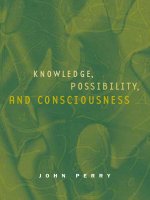the mit press brain-wise studies in neurophilosophy dec 2002
Bạn đang xem bản rút gọn của tài liệu. Xem và tải ngay bản đầy đủ của tài liệu tại đây (8.89 MB, 486 trang )
Brain-Wise
This page intentionally left blank
Patricia Smith Churchland
Brain-Wise
Studies in Neurophilosophy
A Bradford Book
The MIT Press
Cambridge, Massachusetts
London, England
( 2002 Massachusetts Institute of Technology
All rights reserved. No part of this book may be reproduced in any form by any
electronic or mechanical means (including photocopying, recording, and information
storage and retrieval) without permission in writing from the publisher.
This book was set in Times New Roman on 3B2 by Asco Typesetters, Hong Kong, and
was printed and bound in the United States of America.
Library of Congress Cataloging-in-Publication Data
Churchland, Patricia Smith.
Brain-Wise : studies in neurophilosophy / Patricia Smith Churchland.
p. cm.
Includes bibliographical references and index.
ISBN 0-262-03301-1 (hc : alk. paper) — ISBN 0-262-53200-X (pbk : alk. paper)
1. Neurosciences—Philosophy. 2. Cognitive science—Philosophy. I. Title: Studies in
neurophilosophy. II. Title.
[DNLM: 1. Neuropsychology. 2. Knowledge. Metaphysics. 4. Neurology.
5. Philosophy. 6. Religion and Psychology. WL 103.5 C563b 2002]
RC343 .C486 2002
153
0
.01—dc21 2002066024
10987654321
Contents
Preface vii
1 Introduction 1
I Metaphysics 35
2 An Introduction to Metaphysics 37
3 Self and Self-Knowledge 59
4 Consciousness 127
5 Free Will 201
II Epistemology 239
6 An Introduction to Epistemology 241
7 How Do Brains Represent? 273
8 How Do Brains Learn? 321
III Religion 371
9 Religion and the Brain 373
Notes 403
References 421
Index 451
vi Contents
Preface
A lot of water has passed over the dam since I published Neurophilosophy in
1986. Groundbreaking advances have been made in computational methods,
in neuroscientific techniques, and in cross-fi eld connections. Fruitful inter-
actions have developed, for exa mple, between molecular biology and neuro-
science, and between experimental psychology and neuroscience. Philosophers,
initially wary (to put it politely) of the idea that neuroscience might have some
relevance to the problems they call their own, have slowly warmed to the idea
of neurophilosophy. Two decades ago, proposing an undergra duate course in
neurophilosophy was more or less a bad joke. Now such courses are beginning
to spring up even in depart ments that had been proudly ‘‘antibrain.’’ Students
not only in philosophy but also in the sciences are signing up and eagerly
attacking philosophy’s Big Problems—such as the nature of consciousness, free
will, and the self—in full recognition that neuroscientific data are indispensable
to making progress. Alert to the change in philosophical winds, various people
began to needle me concerning the absence of an introductory, single-authored
neurophilosophy text. This book is the response to that needling.
I have assumed that an introductory text should provide a basic frame-
work for how the brain sciences—the neurosciences and cognitive science —
can interface with traditional topics in philosophy. Insofar as it is elementary,
such a text should be as compact and uncluttered as is consistent with being
pedagogically serviceable. Of necessity, this means keeping in-text references to
an almost indecent minimum; it means slimming the number of suggested
readings. It means making incendiary choices about which research best illus-
trates a point and which debates are worth recounting. Although selectivity
serves the goal of presenting a fairly clean picture of how I see things, it carries
a price, not least of which is the undying wrath of colleagues who feel sti¤ed by
the trade-o¤ between spare functionality and congested citation. The chips will
have to as fall they may, however, since my primary goal is that the book be
useful to those who want a panoramic view of philosophical problems as they
appear from the vantage point of the brain sciences. I could not reasonably aim
to make this book encyclopedic; I could aim to make it coherent and compact.
To be useful as an introduction, a book ought not to presuppose very much
background knowledge of the subject. I have tried to abide by that rule. What I
have presupposed is that readers totally unacquainted with neuroscience or
with cognitive science will choose a good text to have handy in case of need. To
assist in that choice, I make some general suggestions in the reading list of the
introductory chapter, and topic-specific suggestions in subsequent chapters.
There are excellent journals, websites, and encyclopedias to augment a begin-
ner’s background, and I have also listed a subset of those journals that contain
good review papers or that are widely considered indispensable to keeping
abreast of the developments in the brain sciences.
The book contains more neurobiological detail than one would typically find
in a philosophy text. The rational e derives from the need to illustrate—and not
merely preach—that understanding the neuroscientific detail is no mere frill if
you intend to do more than play at philosophical problems, such as the nature
of consciousness or learning. A continuing di‰culty for philosophers is to be
su‰ciently versed in basic neuroscience to be able to tell whether the results of
a reported experiment mean anything, and if so, what. Though I cannot solve
this di‰culty, I might reduce its size by conveying the need to understand the
experimental design, the nature of the controls, possible flaws of interpretation,
and so forth by discussing detail from selected experiments.
Though experimental detail is crucial, it is also important not to smother
one’s cognitive operations. They need time and space to mull. As philosopher
and computer scientist Brian Smith once mused, some things that brains do
very well, they do very slowly, over long stretches of time, and in a chewing-on-
the-cud sort of way. These are typically the problem-solving and creative things
that existing computers cannot do at all. In the same vein, Francis Crick
observes that if you are too busy, you are probably wasting your time. With
this thought in mind, I have reigned in my impulse to recommend readings ad
infinitum. Since those readings I do recommend reflect my particular preju-
dices, curious readers will want to go afield for other points of view.
Again and again I have found the history of science invaluable in getting my
bearings. The fact is, neuroscience is still an immature science, in the sense that
it is still gro ping for the fundamental explanatory principles governing brain
function. In this respect, it contrasts with molecular biology, for example,
viii Preface
where the basic principles of the chemical structure of genes, how genes get
turned on and o¤, and how proteins get made are essentially in place. Because
neuroscience is still wet behind the ears, we probably have only the vaguest
glimmerings of what remains to be discovered and no idea how the discoveries
will change our heartfelt convictions about the nature of the mind. Heartfelt
convictions, unavoidable though they may be, can be an intellectual nuisance.
They have a way of posing as nonnegotiable certainties,asverities, and as
metaphysical truths. Despite their convincing pose, they in fact are just bits of
conventional wisdom. The history of science provides bracing tales of conven-
tional wisdom as obstructing progress, as failure of imagination, and as dogma.
History also shows both that sometimes the crackpots turn out to be right, but
that being a crackpot is no guarantee of being right.
In hopes that the history might be likewise useful for others, I found myself
telling science stories where they provide a helpful slant on current problems.
These are tales about scientific error and scientific discovery, about scientific
tenacity and humility, as well as about scientific arrogance and scientific obliv-
ion. Many are stories of conventional wisdom turned arse over teakettle. Their
particular relevance pertains to the search for knowledge in the broadest sense,
irrespective of the topic. By putting some distance between us and our heartfelt
convictions, these stories give us room to think. Oddly, the history of science is
seldom taught to science students, yet it is this history that helps generate a
sense of how to ask the right questions and how progress on the tough prob-
lems can be made.
Not surprisingly, I have also found the history of philosophy invaluable in
putting current philosophical orthodoxy at arm’s length. This is not because I
subscribe to the goofy theory according to which the historical giants knew
more because they knew less. I emphatically do not. Rather, it is because some
of the greats were just a whole lot broader in their interests and a whole lot
more curious about nature in general than are many of today’s mainstream
philosophers. This is manifestly true of those oldies for whom I have enduring
fondness: Aristotle, Hume, and Peirce. My fondness is also explained by the
get-on-with-it r eason that they are clear and sensible, logical and bold. While
these are not virtues for cult figures, they are virtues if one is trying to under-
stand the nature of things.
In my opinion, much of what is considered not quite mainstream philosophy
is where the exciting action is now to be found in academic philosophy. This
work is enthusiastically cross-disciplinary. It leaves the borders between aca-
demic disciplines looking like the mere administrative conveniences they should
ix Preface
be. Philosophy students are plugging into congenial labs, while students in
neuroscience, cognitive science, and computer science are coming to realize that
philosophical questions about the mind are at bottom just broad questions
about the mind, and they can be addressed through experimental tech niques.
They are also learning that philosophy is often useful in showing where the
logical minefields lie. This trend is putting blood back into philosophy, making
it much more akin to the vigorous and expansive discipline it has been through
most of its very long history . This trend is also heartening to those students
who were lured into neuroscience by the big questions but found themselves
endlessly tagging proteins.
Over the years so many people have taught me about the brain and about
how to do science that I cannot begin properly to thank them all. Let me
start, however, with Francis Crick, who has been a constant fount of ideas,
not only of predictably ingenious ones but also, occasionally at least, of reas-
suringly flawed ones. His relentlessness in addressing a problem, accompanied
by warnings to avoid falling in love with one’s own theory, gave me the pluck
to try things I might otherwise have shied away from. Additionally, Francis has
been a consistently fair-minded critic of both my enduring enthusiasms and my
ranch-hand skepticism. His knowledge of the history of science, and especially
his personal and detailed knowledge of the history of molecular biology, has
given me a perspective on neuroscience as a science that I could not have had in
any other way.
Antonio and Hannah Damasio have patiently taught me how to think about
systems-level neuroscience, and have generously shared their insights gleaned
from clinical studies. They also firmly but kindly hoisted me out of a rut into
which I had comfortably settled. In particular, they caused me to begin looking
at consciousness from the perspective of the brain’s fundamental ‘‘coherencing’’
functions, as well as from its perceptual functions. In turn, this led me to follow
them to consider subcortical brain structures, especially brainstem structures,
as the anchor for coherent behavior, and hence for self-representational
capacities.
Brain-Wise also turned out to be every inch a family endeavor. Paul
Churchland, as always, shared all his hunches and insights with me, laughed at
my mistakes, and gave me broad shoulders to stand on. He also drafted many
of the illustrations. Mark Churchland and Anne Churchland, steeped in phi-
losophy as a matter of household routine and in neuroscience as a matter of
professional training, took earlier versions of the manuscript to the woodshed.
Free of any need to be polite, they repeatedly sent me back for wholesale, and
x Preface
badly needed, rethinking and rewriting. Marian Churchland did me the honor
of letting loose her cartoonist’s whimsy to compose the cover, and Carolyn
Churchland gave me sensible advice for the chapter on religion. I am pro-
foundly grateful.
I the world at large, Roderick Corriveau taught me about neural develop-
ment, and added depth to chapters on representations and knowledge. My
UCSD colleague Rick Grush has been a collaborator on several projects, and
his ideas about emulators have been a central element in my thinking about
how nervous systems self-represent. I must especially thank my friend and col-
league Clark Glymour, who, with his mixture of intellectual rigor and take-no-
prisoners honesty, taught me a lot about causation and gave me the spine to
say what I really think. David Molfese went over the manuscript page by page
and consistently suggested very smart improvements, both substantive and ed-
itorial. Save for the methodical determination of David, this book would have
been forever in progress. Ilya Farber was also wonderfully helpful, both criti-
cally and in his perspective on the integration of scientific domains. Steve
Quartz gave me ideas about brain evolution that helped reorient my thinking
about modules and brain organization generally. Michael Stack, my long-time
philosophical chum, helped me tighten up many arguments and spotted sec-
tions that sounded pompous. Terry Sejnowski kindly read some of the manu-
script and gave me advice and ideas, especially about learning and memory,
and spatial representation. My editor at the MIT Press, Alan Thwaits, gave me
the kind of invaluable advice one gets from a top-notch editor. I owe him a
large debt of thanks.
Others who read the manuscript and commented, browbeat, or encouraged
me into improvements are Bill Casebeer, Carmen Carrillo, Lou Goble, Mitch
Gunzler, Andrew Hamilton, John Jacobson, Don Krueger, Ed McAmis, and
Clarissa Waites. The Sejnowski lab at the Salk Institute is my second home,
where I can learn about the latest developments and try out ideas. I am grateful
to all those in the lab who have taken the time to bring me up to speed on their
experiments and share their speculations, doubts, and wild ideas. I have taken
the liberty of testing the manuscript on two undergraduate classes at UCSD,
and their feedback has provoked many revisions, especially in the choice of
topics to emphasize. Too numerous to mention, these students have my grati-
tude for their comments and complaints. Pippin ‘‘Bubbles’’ Schupbach gave me
cheerful assistance in a vast range of chores.
UCSD has been the most exciting place in the world for me during the eigh-
teen years it has been my home, and I am deeply grateful to many colleagues
xi Preface
for having the kindness to teach me what they know. This is especially true of
Liz Bates, Gilles Fauconnier, ‘‘Rama’’ Ramachandran, Marty Sereno, and
Larry Squire. Finally, I am particularly pleased to note that when he was
chancellor at UCSD, Dick Atkinson was uncommonly encouraging, even in
the early days when my work was dismissed by mainstream philosophers as not
real philosophy. As president of the University of California, he continues to
keep abreast of what ‘‘his’’ faculty are thinking and doing, and gives us feed-
back. He is a visionary, and I have much to thank him for.
La Jolla, California, 2002
xii Preface
Brain-Wise
This page intentionally left blank
1 Introduction
The goal of science is not to open the door to everlasting wisdom, but to set a limit on
everlasting error.
Galileo, in Galileo, by Bertolt Brecht
1 Core Questions
Bit by experimental bit, neuroscience is morphing our conception of what we
are. The weight of evidence now implies that it is the brain, rather than some
nonphysical stu¤, that feels, thinks, and decides. That means there is no soul to
fall in love. We do still fall in love, certainly, and passion is as real as it ever
was. The di¤erence is that now we understand those important feelings to be
events happening in the physical brain. It means that there is no soul to spend
its postmortem eternity blissful in Heaven or miserable in Hell. Stranger yet, it
means that the introspective inside—one’s own subjectivity—is itself a brain-
dependent way of making sense of neural events. In addition, it means that the
brain’s knowledge that this is so is likewise brain-based business.
Given what is known about the brain, it also appears highly doubtful that
there is a special nonphysical module, the will, operating in a causal vacuum to
create voluntary choices—choices to be courageous in the face of danger, or to
run away and fight another day. In all probability, one’s decisions and plans,
one’s self-restraint and self-indulgences, as well as one’s unique individual char-
acter traits, moods, and temperaments, are all features of the brain’s general
causal organization. The self-control one thinks one has is anchored by neural
pathways and neurochemicals. The mind that we are assured can dominate
over matter is in fact certain brain patterns interacting with and interpreted by
other brain patterns. Moreover, one’s self, as apprehended introspectively and
represented incessantly, is a brain-dependent construct, susceptible to change as
the brain changes, and is gone when the brain is gone.
Consciousness, almost certainly, is not a semimagical glow emanating from
the soul or permeating spooky stu¤. It is, very probably, a coordinated pattern
of neuronal activity serving various biological functions. This does not mean
that consciousness is not real. Rather, it means that its reality is roote d in its
neurobiology. That a brain can come to know such things as these, and in par-
ticular, that it can do the science of itself, is one of the truly stunning capacities
of the human brain.
This list catalogues but a few of the scientific developments that are revolu-
tionizing our understanding of ourselves, and one would have to be naive to
suppose that things have ‘‘gone about as far as they can go.’’ In general terms,
the mind-body problem has ceased to be the reliably tangled conundrum it
once was. During the last three decades, the pace of discovery in neuroscience
has been breathtaking. At every level, from neurochemicals to cells, and on-
wards to the circuit and systems levels, brain research has produced results
bearing on the nature of the mind (figures 1.1 and 1.2). Coevolving with neu-
roscience, cognitive science has probed the scope of large-scale functions such
as attention, memory, perception, and reasoning both in the adult and in the
developing infant. Additionally, computational ideas for linking large-scale
cognitive phenomena with small-scale neural phenomena have opened the door
to an integration of neuroscience, cognitive science, and philosophy in a com-
prehensive theoretical framework.
There remain problems galore, and the solution to some of these problems
will sur ely require conceptual and theoretical innovation of a magnitude that
will surprise the pants o¤ us. Most assuredly, having achieved significant pro-
gress does not imply that only mopping-up operations remain. But it does
mean that the heyday of unfettered and heavy-handed philosophical specula-
tion on the mind has gone the way of the divine right of kings, a passing that
has stirred some grumbling among those wearing the mantle of philosopher-
king. It does mean that know-nothing philosophy is losing ground to empiri-
cally constrained theorizing and inventive experimentation.
If the aforementioned changes have emerged from discoveries in the various
neurosciences—including neuroanatomy, neurophysiology, neuropharmacology,
and cognitive science—wherefore philosophy? What is neurophilosophy, and
what is its role? Part of the answer is that the nature of the mind (including the
nature of memory and learning, consciousness, and free will) have traditionally
been subjects within the purview of philosophy. Philosophers, by tradition,
2 Introduction
have wrestled with these topics, and the work continues. Neurophilosophy
arises out of the recognition that at long last, the brain sciences and their
adjunct technology are su‰ciently advanced that real progress can be made
in understanding the mind-brain. More brashly, it predicts that philosophy of
mind conducted with no understanding of neurons and the brain is likely to be
sterile. Neurophiloso phy, as a result, focuses on problems at the intersection of
a greening neuroscience and a graying philosophy.
Another part, perhaps the better part, of the answer is that philosophy, tra-
ditionally and currently, is quintessentially the place for synthesizing results
and integrating theories across disciplinary domains. It is panoramic in its
scope and all-encompassing in its embrace. It unabashedly bites o¤ much more
than it can chew. Any hypothesis, be it ever so revered or ever so scorned, is
considered fair game for criticism. Philosophy deems it acceptable to kick the
Figure 1.1 Organized structures are found at many spatial scales in nervous systems.
Functional levels may be even more fine-grained. Thus dendrites are a smaller compu-
tational unit than neurons, and networks may come in many sizes, including local net-
works and long-range networks. Networks may also be classed according to distinct
dynamical properties. Icons on the right depict distinct areas in the visual system (top), a
network (middle), and a synapse (bottom). (Based on Churchland and Sejnowski 1988.)
3 Introduction
tires of every governing paradigm, examine every sacred cow, and peer behind
the curtains of every magic show.
Under this description, we are all philosophers from time to time. Certainly,
scientists have their philosophical hours, when they push back from the bench
and stew on the broad questions, or when they beat on the conventional wis-
dom and strike a blow for originality. Such philosophical hours prepare the
ground for the germination of new ideas and new experimental techniques .
Politely, we can consider philosophy the theoretical companion to experi-
mental science; less politely, we can consider it merely woolgathering and free-
lancing. Certainly, some philosophy is just horsing around. Yet that is no bad
thing, especially when a science is in its nascent stages. Neuroscience is a
nascent science, and theoretical innovation is needed in every subfield of that
broad u
¨
ber-field. Most theoretical ideas are bound to be losers, of course, but
unless we are courageous enough to nurture lots and lots of new ideas, the
rightful winners will never see the light of day.
This description highlights the positive side of philosophizing, but as with
anything else, there is a seamier side. This is the side revealed when one is lulled
into taking one’s untested theoretical fancies as fact, or equating theory beau-
tiful with theory true, or rejecting unorthodox ideas as heresy because they are
unorthodox, or supposing that some chummy circle has the corner on clever
ideas. If this applies to philosophy, it applies just as well to science, govern-
ment, finance, and war.
Figure 1.2 Logarithmic scales for spatial and temporal magnitudes. Brackets indicate
the scales especially relevant to synaptic processing. (Based on Shepherd 1979.)
4 Introduction
This book is about neurophilosophy. It aims to take stock of various philo-
sophical problems concerning the nature of the mind, given the recent bonanza
of developments in neuroscience and cognitive science. In finding a path
through the thicket of relevant neuroscientific studies and discoveries, I found
material assembling itself into two classical categories: metaphysics and epis-
temology. Ethics gets a brief look in my discussion of free will and responsi-
bility, but is mainly undiscussed on this occasion. Religion is the subject of the
closing chapter, and has both a metaphysical and an epistemological dimension.
Before plunging on, we shall limber up with a few brief historical points and
a short discussion on reductionism, a pivotal concept whose clarity is no luxury
as we begin to assay the integration of hitherto separated domains.1
2 Natural Philosophy
Greek thought in the period 600 b.c. to 200 a.d. was the fountainhead for
Western philosophy generally, as well as for modern science. In those days,
philosophy literally meant ‘‘love of wisdom,’’ and for the ancient Greeks, phi-
losophy targeted a vast range of questions, such as, What is the nature of
change such that water can freeze or wood burn? What is the nature of the
moon and stars, and where did Earth come from? Are there fundamental par-
ticles of which all objects are composed? How do living things reproduce? In
addition, of course, they raised questions about themselves—about what it is to
be human, to think and perceive, to reason and feel, to plan and decide, to live
a good life, to organi ze a harmonious and productive political state.
Theories about the natural world were considered part of natural philosophy.
By contrast, theories of ethics and politics and practical life were part of moral
philosophy. To a first approximation, this classification separates questions
about how things are from questions about what we should do. Though distinct,
these two domains share concepts and theories. In particular, sometimes ques-
tions about the mind will have one foot in each of these areas.
When did philosophy come to be considered a separate discipline? By the
end of the nineteenth century, advances in some domains of natural philosophy
had developed so extensively that separate subfields—physics, chemistry, as-
tronomy and biology—branched o¤ as distinct sciences. With progress and
specialization, the exp ression ‘‘natural science’’ gained currency, while the more
old-fashioned term, ‘‘natural philosophy’’ faded from use, now being essentially
archaic. Nonetheless, this broad title can still be found on science buildings and
5 Introduction
doorways in older universities such as Cambridge in England and St. Andrews
in Scotland. Until the middle of this century, St. Andrews’s degrees in physics
were o‰cially degrees in Natural Philosophy. The title Ph.D. (Philosophae
Doctor, or ‘‘teacher of philosophy’’) is awarded not only to philosophers, but to
scientists of all sorts. It is a vestige of the older classification, which embraces
all of science as a part of natural philosophy.
If the stars, the heart, and the basic constituents of matter became under-
stood well enough to justify a separate science, what about the mind? Ancient
thinkers, such as the physician Hippocrates (460–377 b.c.), were convinced that
thoughts, feelings, and percep tions were activities of the brain. He believed that
events such as sudden paralysis or creeping dementia had their originating
causes in brain damage. And this implied, in his view, that normal movement
and normal speech had their originating causes in the well-tempered brain. On
the other hand, philosophers favoring a nonnatural framework—Plato (427–
347 b.c.), and especially later Christian thinkers such as St. Thomas Aquinas
(1225–1274) and St. Augustine (354–430)—believed the soul to be distinct
from the body and divine in origin. Plato, in perhaps the first systematic theo-
rizing on the soul, hypothesized it to have a sensible part (which determines
perceptions), an emotional part (by virtue of which we feel honor, fear, and
courage), and a rational part. This last was considered unique to humans and
allowed us to reason, think, and figure things out. Theologically minded phi-
losophers concluded that the mind (or, one might say, the soul ) was a subject
for study by means other than those available to natural science. If super-
naturalism was true of the soul, then the nature of the soul could not be
revealed by natural science, though perhaps other methods—such as medita-
tion, introspection, and reason—might be useful.
Descartes (1595–1650) articulated the modern version and systematic de-
fense of the idea that the mind is a nonphysical thing. This dual-substance view
is known as dualism. Reason and judgment, in Descartes’s view, are functions
inhering in the mental, immaterial mind. He surmised that the mind and the
body connect at only two points: sensory input a nd output to the muscles.
Apart from these two functions, Cartesian dualism assumes that the mind’s
operations in thought, language, memory retrieval, reflection and conscious
awareness proceed independently of the brain. When clinical studies on brain-
damaged patients showed clear dependencies between brains and all these os-
tensibly brain-independent functions, classical dualism had to be reconfigured
to allow that brain-soul interactions were not limited to sensory and motor
6 Introduction
functions. Achieving this correction without rendering the soul exp lanatorily
redundant has been the bane of post-Cartesian dualism.
What about dualism appealed to Descartes? First, he was particularly im-
pressed by the human capacity for reasoning and language, and the degree to
which language use seems to be governed by reasons rather than causes. More
exactly, he confe ssed that he was completely unable to imagine how a me-
chanical device could be designed so as to reason and use language appropri-
ately and creatively.
What sort of mechanical devices were available to propel Descartes’s imag-
ination? Only clockwork machines, pumps, and fountains. Though some of
these were remarkably clever, even the most elaborate clockwork devices of the
seventeenth century were just mecha nical. Well beyond the seventeenth-century
imagination are modern computers that can guide the path of a cruise missile
or regulate the activities of a spacecraft on Mars. In an obvious way, Des-
cartes’s imagination was limited by the science and technology he knew about.
Had he been able to contemplate the achievements of computers, had he had
even an inkling of electronics, his imagination might have taken wing. On the
other hand, the core of Descartes’s argument was revived in the 1970s by
Chomsky2 and Fodor3 to defend their conviction that nothing we will ever
understand about the brain will help us very much to understand the nature of
language production and use.
The second reason dualism appealed is closely connected to the first. Des-
cartes was convinced that exercise of free will was inconsistent with causality.
He was also sure that humans did indeed have free will, and that physical
events were all caused. So even if the body was a just a mechanical device, the
mind could not be. Minds, he believed, must enjoy uncaused choice. We can
undertake an action for a reason, but the relations between reasons and choices
are not causal. Animals, by contrast, he believed to be mere automata, without
the capacity for reason or for free choice. In its core, if not in its details, this
argument too is alive and well even now, and it will be readdressed in greater
detail in chapter 5 in the context of the general topic of free will.
Third, Descartes was impressed by the fact that one seems to know one’s
own conscious experiences simply by having them and attending to them. By
contrast, to know about your experiences, I must draw inferen ces from your
behavior. Whereas I know I have a pain simply by having it, I must draw an
inference to know that my body has a wound. I cannot be wrong that I am
conscious, but I can be wrong that you are conscious. I can even be wrong that
7 Introduction
you exist, since ‘‘you’’ might be nothing but my hallucination. According to
Descartes’s argument, di¤erences in how we know imply that the thing that has
knowledge—the mind—is fundamentally di¤erent from the body. The mind,
he concluded, is essentially immaterial and can exist after the disintegration of
the body. Like the other two arguments for dualism, this argument has
remained powerful over the centuries. It has been touched up, put in modern
dress, and in general reworked to look as good as new, but Descartes’s insights
regarding knowledge of mental states constitute the core of virtually all recent
work on the nonreducibility of consciousness.4 Because it continues to be per-
suasive, this argument will be readdressed and analyzed in detail when we dis-
cuss self-knowledge and consciousness. (See especially chapter 3, but also
chapters 4 and 6.)
How, in Descartes’s view, is the body able causally to a¤ect the mind so that
I feel pain when touching a hot stove? How can the mind a¤ect the body so
that when I decide to scratch my head, my body does what I intend it should
do? Although Descartes envisioned interaction as limited to sensory input and
motor output, notice that the business of interaction—any interaction—turns
out to be a vexing problem for dualism, no matter how restricted or rich the
interactions are believed to be. The interaction problem was, moreover, recog-
nized as trouble right from the beginning. How could there be any causal
interaction at all, was the question posed by other philosophers, including his
contemporary, Princess Elizabeth of Holland, who put her objection bluntly in
a letter of 10/20 June 1643: ‘‘And I admit that it would be easier for me to
concede matter and extension to the soul than to concede the capacity to move
a body and be moved by it to an immaterial thing’’ (Oeuvres de Descartes, ed.
C. Adam and P. Tannery, vol. III, p. 685). As Princess Elizabeth realized, the
mind, as a mental substance, allegedly has no physical properties; the brain, as
a physical substance, allegedly has no mental properties. Slightly updated, her
question for Descartes is this: how can the two radically di¤erent substances
interact? The mind allegedly has no extension, no mass, no force fields—no
physical properties at all. It does not even have spatial boundaries or locations.
How could a nonphysical thing cause a change in a physical thing, and vice
versa? What could be the causal basis for an interaction? Somewhat later,
Leibniz (1646–1716) described the problem as intractable:5 ‘‘When I began to
meditate about the union of soul and body, I felt as if I were thrown again into
the open sea. For I could not find any way of explaining how the body makes
anything happen in the soul, or vice versa, or how one substance can commu-
nicate with another created substance. Descartes had given up the game at this
8 Introduction
point, as far as we can determine from his writings’’ (from A New System of
Nature, translated by R. Ariew and Daniel Garber, p. 142).
Descartes almost certainly did reco gnize that mind-body interaction was a
devastating di‰culty, and indeed it has remained a stone in the shoe of dualism
ever since. (For additional discussion, see chapter 2.)
The di‰culty of giving a positive account provoked some philosophers,
Leibniz being the first, to assert that events in a nonphysical mind are simply
separate phenomena running in parallel to events in the brain. The mind causes
nothing in the brain, and the brain causes nothing in the mind. Known as psy-
chophysical parallelism, the idea was that the parallel occurrence of mental and
brain events gives the illusion of causal interaction , though in fact no such
causation ever actually occurs. What keeps the two streams in register? Some
parallelists, such as Malebranche, thought this was a job God regularly and
tirelessly performs for every conscious subject every waking hour. Leibniz, who
preferred the idea that God kicked o¤ the two streams and then let them alone,
disparaged ‘‘occasionalists’’ such as Malebranche: ‘‘[Descartes’s] disciples . . .
judged that we sense the qualities of bodies because God causes thoughts to
arise in the soul on the occasion of motions of matter, and that when our soul,
in turn, wishes to move the body, it is God who moves the body for it’’ (p. 143).
Descartes’s best attempt to explain the interaction between mind and body
was the suggestion that some unobserved but very, very fine material—material
—in the pineal gland of the brain brokered the interaction between nonphysical
mind and physical bra in. His critics, such as Leibniz, were not fooled.
Perhaps Descartes was not fooled either. Some historians argue that Des-
cartes’s defense of a fundamental di¤erence between mind and body was actu-
ally motivated by political rather than intellectual considerations.7 Descartes
was unquestionably a brilliant scientist and mathematician. This is, after all,
the Descartes of the Cartesian coordinate system, a stunning mathematical
innovation for which he is rightly given credit. He also understood well the
bitter opposition of th e Church to developments in science, and had left France
to live in Holland to avoid political trouble. It is possible that he feared that
developments in astronomy, physics, and biology would be cut o¤ at the knees
unless the Church was reassured that the ‘‘soul’’ was its unassailable propri-
etary domain. Such a division of subject matter might permit science at least to
have the body as its domain. Whether this interpretation does justice to the
truth remains controv ersial.
Certainly some of Descartes’s arguments, both for the existence of God as
well as for the mind/body split, are su‰ciently flawed to suggest that they are
9 Introduction
ostentatiously flawed. On this hypothesis, the genius Descartes knew the logic
full well and planted the flaws as clues for the discerning reader. And certainly
Descartes had good reason to fear the Church’s power to thwart scientifi c in-
quiry and to punish the scientist. Burning, torturing, and exiling those who
inquired beyond o‰cial Church doctrine was not uncommon. Galileo, for ex-
ample, was ‘‘shown the instruments of torture’’ to force him to retract his claim
that Earth revolved around the Sun, a claim based on observation and reason-
ing. Recant he did, rather than submitting to the rack and iron maiden, but
even so, he spe nt the rest of his life under house arrest by Church authorities.
By vigorously postulating the mind/body division, perhaps contrary to his own
best scientific judgment, Descartes may have done us all a huge, if temporary,
favor in permitting the rest of science to go forward.
And go forward it did. By the end of the nineteenth century, physics, chem-
istry, astronomy, geology, and physiology were established, advanced scientific
disciplines. The science of nervous systems, however, was a much slower a¤air.
Though some brilliant anatomical work had been done on nervous systems,
particularly by Camillo Golgi (1843–1926) and Santiago Ramo
´
n y Cajal
(1852–1934), even at the end of the nineteenth century, little was known about
the brain’s functional organization, and almost nothing was understood con-
cerning how neurons worked. That neurons signaled one another was a likely
hypothesis, but how and to what purpose was a riddle.
Why did progress in neuroscience lag so far behind progress in astronomy
or physics or chemistry? Why is the blossoming of neuroscience really a late-
twentieth-century phenomenon? This question is especially poignant since, as
noted, Hippocrates some four hundred years b.c. had realized that the brain
was the organ of thought, emotion, perception, and choice.
The crux of the problem is that brains are exceedingly di‰cult to study.
Imagine Hippocrates observing a dying gladiator with a sword wound to the
head. The warrior had lost fluent speech following his injury, but remained
conscious up to the end. At autopsy, what theoretical resources did Hippo-
crates possess to make sense of something so complex as th e relation between
the loss of fluent speech and a wound in the pinkish tissue found under the
skull? Remember, in 400 b.c. nothing was understood about the nature of
the cells that make up the body, let alone of the special nature of cells that
make up the brain. That cells are the basic building blocks of the body was not
really appreciated until the seventeenth century, and neurons were not seen
until 1837, when Purkyne
ˇ
, using a microscope, first saw cell bodies in a section
of brain tissue (figure 1.3).8 Techniques for isolating neurons—brain cells—to
10 Introduction









